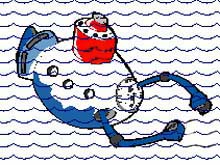
Islands in the Stream: Exploring Underwater Oases will advance our knowledge of the spawning habits of reef fishes, allow scientists to make habitat characterizations and study zonal changes in this poorly-understood region of the South Atlantic Bight. Scientists will also be investigating organisms that produce compounds used in pharmaceutical research, vision of deep water organisms, and bioluminescence in the deep sea.
Education
With the establishment of the Ocean Exploration Program within the National Oceanic and Atmospheric Administration (NOAA), we have a great opportunity reach out in new ways to teachers, students, and the general public and share the excitement of daily discoveries while at sea and the science behind the exploration initiatives sponsored by NOAA. Islands in the Stream 2002: Exploring Underwater Oases will advance our knowledge the poorly-understood region of the South Atlantic Bight. As such, this Expedition has great potential for generating exciting outreach and education opportunities as part of NOAA’s Ocean Exploration Program education efforts.
During the Islands in the Stream 2002: Exploring Underwater Oases Expedition, scientists will use the Harbor Branch Oceanographic Institution’s manned submersible, the Johnson-Sea-Link-II and the 204-ft. Seward Johnson research vessel to study unexplored and little-known areas of the South Atlantic Bight. Scientists are interested in learning more about spawning habits of reef fishes and habitat characterizations and zonal changes in the area. They will also be investigating organisms that produce compounds used in pharmaceutical research, vision of deep water organisms, and bioluminescence in the deep sea.
Educators and scientists working with NOAA during June and July 2002 developed a series of lesson plans for students in Grades 5 – 12 that are specifically tied to the Islands in the Stream 2002: Exploring Underwater Oases Expedition. These lesson plans focus on cutting-edge ocean exploration and research, using state-of-the-art technology, aboard one of the nation’s most sophisticated research vessels and its submersible, the Johnson-Sea-Link-II. The lesson plans focus specifically on the importance of ocean exploration and the research taking place during the Islands in the Stream 2002: Exploring Underwater Oases Expedition, and feature such topics as spawning habitats and behaviors of reef fishes, topographic features of the region, biological communities found on hard bottom areas, vision and bioluminescence in the deep sea, and navigation at sea.
The lesson plans are grouped into the following categories:
Grades 5-6
Grades 7-8
Grades 9-12 (chemical, biological, earth, and physical science).
Each grade-level grouping includes activities that focus on the exploration and research being conducted as part of the Islands in the Stream 2002: Exploring Underwater Oases Expedition. In addition to being tied to the National Science Education Standards, the hands-on, inquiry-based activities include focus questions, background information for teachers, links to interesting Internet sites, and extensions. Web logs that document the latest discoveries and complement the lesson plans, complete with compelling images and video, will be sent back each day from sea. Teachers are encouraged to use the daily logs from the Islands in the Stream 2002: Exploring Underwater Oases Expedition, which are posted on this site, to supplement the lesson plans.
Read a description of each lesson plan and/or download them to your computer.
Sign up for the Ocean Explorer E-mail Update List.














































